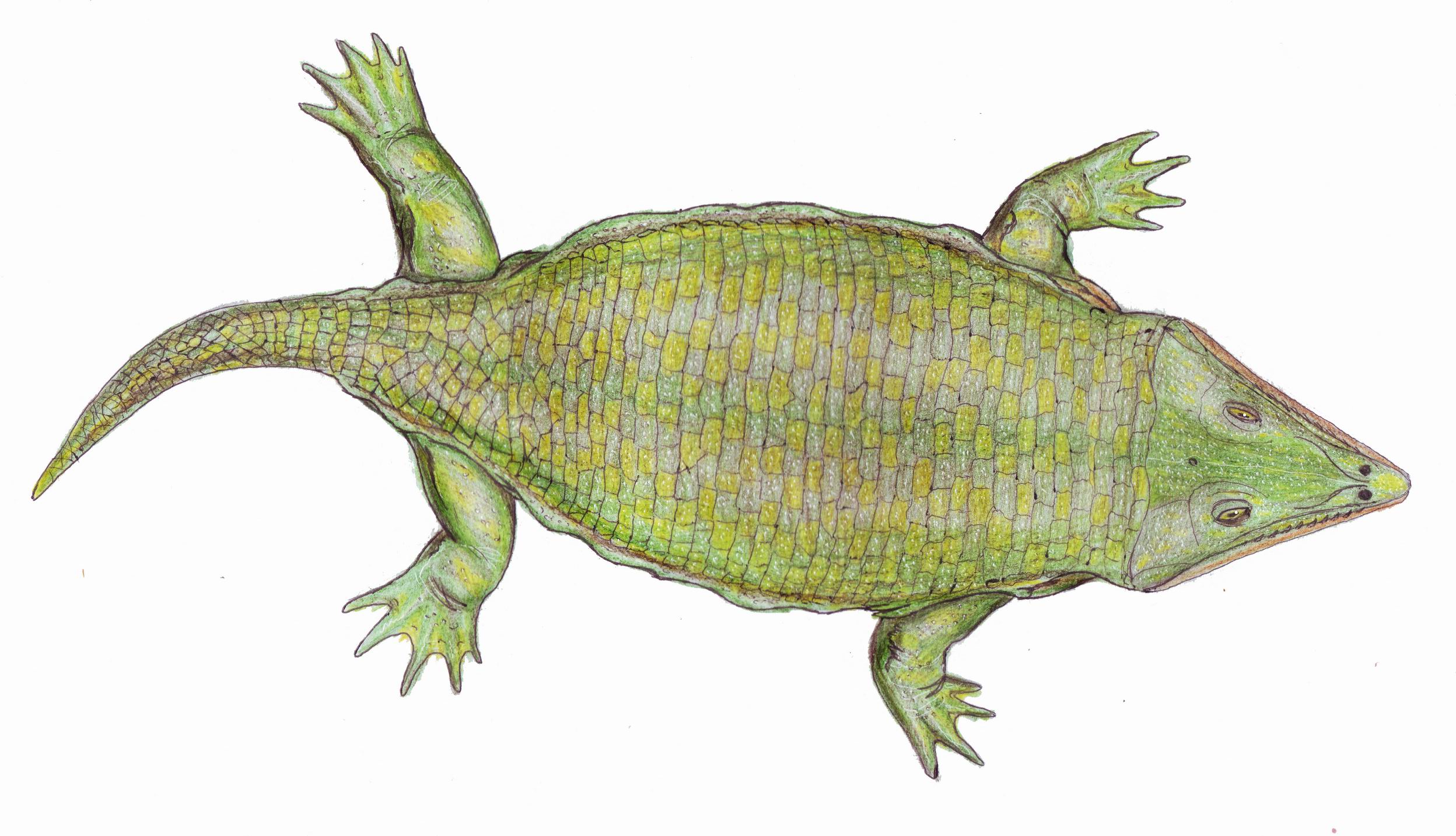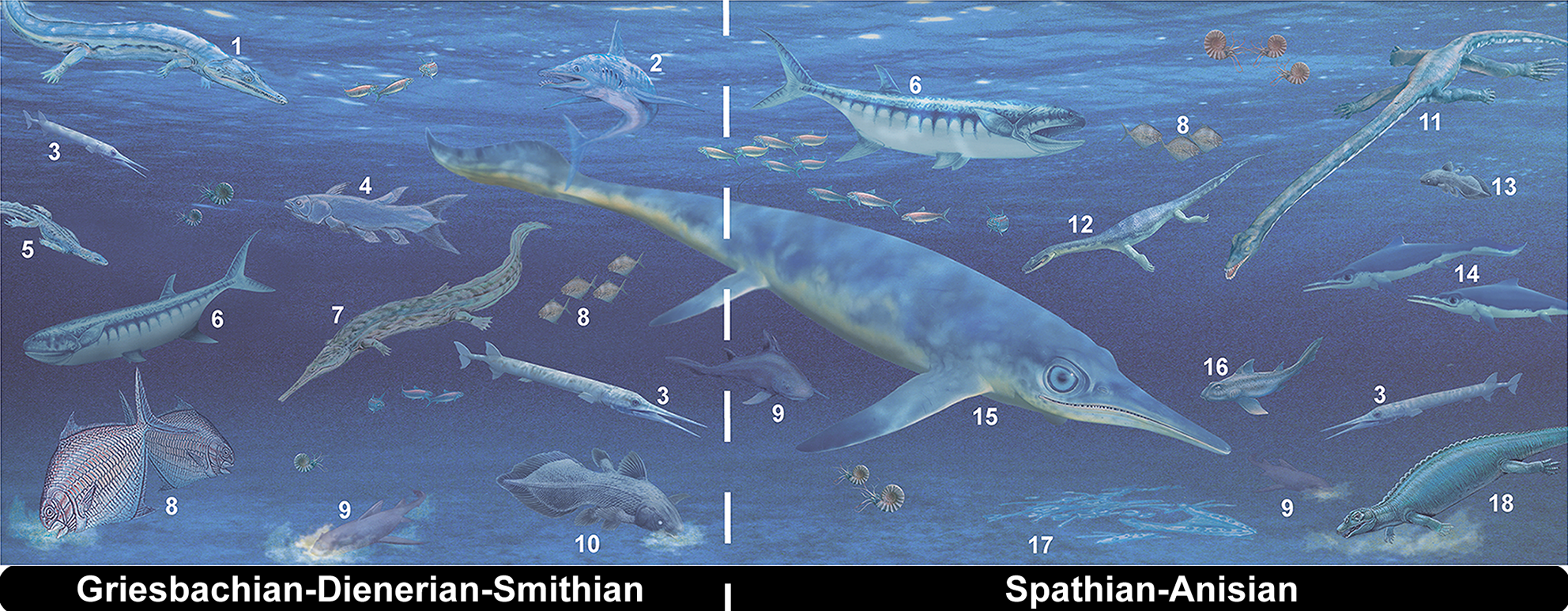|
Rotaurisaurus
''Rotaurisaurus'' is an extinct genus of temnospondyls from the family Lapillopsidae. This genus is known only from an incomplete crushed skull and associated left jaw, together given the designation UTGD (University of Tasmania Geological Department) 87795. The generic name, ''Rotaurisaurus'', is a combination of Latin words translating to "circle-eared lizard". This references the shape of its otic notches, which acquire a circular form due to being partially enclosed by the tabular bones at the back of the skull. The specific name, ''contundo'', references the specimen's poor level of preservation, as it is derived from the Latin word for "squashed". The skull was discovered in 1960 at the Crisp and Gunn Quarry near Hobart, Tasmania. This quarry contains rock layers from the Knocklofty Formation, which is dated to the early Triassic Period. For years this skull was believed to belong to a juvenile individual of '' Chomatobatrachus halei'', a species of lydekkerinid common in ... [...More Info...] [...Related Items...] OR: [Wikipedia] [Google] [Baidu] [Amazon] |
|
|
Lapillopsis
''Lapillopsis'' is an extinct genus of stereospondyl temnospondyl within the family (biology), family Lapillopsidae. Fossils belonging to the genus have been found in the Arcadia Formation (Australia), Arcadia Formation (Rewan Group) of Queensland, Australia. History of study The type species and only known species is ''Lapillopsis nana,'' named in 1990 by Australian scientists Anne Warren and Mark Hutchinson. The name is derived from the Latin ''lapillus'' (pebble) and Greek -''opsis'' (appearance) in reference to the material of this species being collected from within small rocky nodules. There are two known specimens, both nearly complete skulls with associated mandibles and associated postcranial elements. An additional fourteen specimens from the same locality were described by Australian paleontologist Adam Yates in 1999. Anatomy ''Lapillopsis'' was differentiated from the closely related ''Rotaurisaurus'' from Australia by several features: (1) a deep, semi-elliptic ... [...More Info...] [...Related Items...] OR: [Wikipedia] [Google] [Baidu] [Amazon] |
|
|
Lapillopsidae
Lapillopsidae is an extinct family of temnospondyls Temnospondyli (from Greek τέμνειν, ''temnein'' 'to cut' and σπόνδυλος, ''spondylos'' 'vertebra') or temnospondyls is a diverse ancient order of small to giant tetrapods—often considered primitive amphibians—that flourished wo .... ''Lapillopsis'' was found as the sister to ''Rotaurisaurus'' in a 1999 analysis that found the Lapillopsidae as basal stereospondyls. ''Lapillopsis'' was found as a sister to Dissorophoidea by a 2017 analysis. Another relative of ''Lapillopsis'', ''Manubrantlia'' was described from the Early Triassic of India, and ''Rhigerpeton'' was found in Antarctica. References * Stereospondyli Triassic temnospondyls Temnospondyl families {{Temnospondyli-stub ... [...More Info...] [...Related Items...] OR: [Wikipedia] [Google] [Baidu] [Amazon] |
|
|
Knocklofty Formation
The Knocklofty Formation is an Early Triassic geologic formation from southern Tasmania, Australia, belonging to the Induan stage. It was deposited in a terrestrial, freshwater environment, and is primarily composed of shale and sandstone. List of known fossil taxa Tetrapods * ''Banksiops townrowi'''''' * ''Chomatobatrachus halei'''''' * ''Deltasaurus kimberleyensis'''''' * '' Derwentia warreni'' * ''Rotaurisaurus contundo'''''' * ''Tasmaniosaurus triassicus'''''' * ''Watsonisuchus'' sp. Fish * ''Ceratodus'' sp. * ''Saurichthys ''Saurichthys'' (from , 'lizard' and 'fish') is an extinct genus of predatory Actinopterygii, ray-finned fish from the Triassic period (geology), Period. It is the type genus of the family (taxonomy), family Saurichthyidae (Changhsingian-Ju ...'' sp. * '' Cleithrolepis'' sp. * '' Acrolepis tasmanicus'' References Induan Stage Paleontology in Australia Paleontology in Tasmania {{Australia-geology-stub Geologic formations o ... [...More Info...] [...Related Items...] OR: [Wikipedia] [Google] [Baidu] [Amazon] |
|
 |
List Of Prehistoric Amphibians
This list of prehistoric amphibians is an attempt to create a comprehensive listing of all genera from the fossil record that have ever been considered to be amphibians, excluding purely vernacular terms. The list includes all commonly accepted genera, but also genera that are now considered invalid, doubtful ('' nomina dubia''), or were not formally published (''nomina nuda''), as well as junior synonyms of more established names, and genera that are no longer considered amphibians. Modern forms are excluded from this list. The list currently includes 457 names. Naming conventions and terminology Naming conventions and terminology follow the International Code of Zoological Nomenclature. Technical terms used include: * Junior synonym: A name which describes the same taxon as a previously published name. If two or more genera are formally designated and the type specimens are later assigned to the same genus, the first to be published (in chronological order) is the senior synony ... [...More Info...] [...Related Items...] OR: [Wikipedia] [Google] [Baidu] [Amazon] |
 |
Early Triassic
The Early Triassic is the first of three epochs of the Triassic Period of the geologic timescale. It spans the time between 251.9 Ma and Ma (million years ago). Rocks from this epoch are collectively known as the Lower Triassic Series, which is a unit in chronostratigraphy. The Early Triassic is the oldest epoch of the Mesozoic Era. It is preceded by the Lopingian Epoch (late Permian, Paleozoic Era) and followed by the Middle Triassic Epoch. The Early Triassic is divided into the Induan and Olenekian ages. The Induan is subdivided into the Griesbachian and Dienerian subages and the Olenekian is subdivided into the Smithian and Spathian subages. The Lower Triassic series is coeval with the Scythian Stage, which is today not included in the official timescales but can be found in older literature. In Europe, most of the Lower Triassic is composed of Buntsandstein, a lithostratigraphic unit of continental red beds. The Early Triassic and partly also the Middle Trias ... [...More Info...] [...Related Items...] OR: [Wikipedia] [Google] [Baidu] [Amazon] |
|
Archosaur
Archosauria () or archosaurs () is a clade of diapsid sauropsid tetrapods, with birds and crocodilians being the only extant taxon, extant representatives. Although broadly classified as reptiles, which traditionally exclude birds, the cladistics, cladistic sense of the term includes all living and extinct relatives of birds and crocodilians such as non-avian dinosaurs, pterosaurs, phytosaurs, aetosaurs and rauisuchians as well as many marine reptile#Extinct groups, Mesozoic marine reptiles. Modern paleontologists define Archosauria as a crown group that includes the most recent common ancestor of living birds and crocodilians, and all of its descendants. The base of Archosauria splits into two clades: Pseudosuchia, which includes crocodilians and their extinct relatives; and Avemetatarsalia, which includes birds and their extinct relatives (such as non-avian dinosaurs and pterosaurs). Older definitions of the group Archosauria rely on shared morphology (biology), morphological ch ... [...More Info...] [...Related Items...] OR: [Wikipedia] [Google] [Baidu] [Amazon] |
|
 |
Orbit (anatomy)
In anatomy Anatomy () is the branch of morphology concerned with the study of the internal structure of organisms and their parts. Anatomy is a branch of natural science that deals with the structural organization of living things. It is an old scien ..., the orbit is the Body cavity, cavity or socket/hole of the skull in which the eye and Accessory visual structures, its appendages are situated. "Orbit" can refer to the bony socket, or it can also be used to imply the contents. In the adult human, the volume of the orbit is about , of which the eye occupies . The orbital contents comprise the eye, the Orbital fascia, orbital and retrobulbar fascia, extraocular muscles, cranial nerves optic nerve, II, oculomotor nerve, III, trochlear nerve, IV, trigeminal nerve, V, and abducens nerve, VI, blood vessels, fat, the lacrimal gland with its Lacrimal sac, sac and nasolacrimal duct, duct, the eyelids, Medial palpebral ligament, medial and Lateral palpebral raphe, lateral palpebr ... [...More Info...] [...Related Items...] OR: [Wikipedia] [Google] [Baidu] [Amazon] |
|
Quadratojugal Bone
The quadratojugal is a skull bone present in many vertebrates, including some living reptiles and amphibians. Anatomy and function In animals with a quadratojugal bone, it is typically found connected to the jugal (cheek) bone from the front and the squamosal bone from above. It is usually positioned at the rear lower corner of the cranium. Many modern tetrapods lack a quadratojugal bone as it has been lost or fused to other bones. Modern examples of tetrapods without a quadratojugal include salamanders, mammals, birds, and squamates (lizards and snakes). In tetrapods with a quadratojugal bone, it often forms a portion of the jaw joint. Developmentally, the quadratojugal bone is a dermal bone in the temporal series, forming the original braincase. The squamosal and quadratojugal bones together form the cheek region and may provide muscular attachments for facial muscles. In reptiles and amphibians In most modern reptiles and amphibians, the quadratojugal is a prominent, st ... [...More Info...] [...Related Items...] OR: [Wikipedia] [Google] [Baidu] [Amazon] |
|
 |
Olenekian
In the geologic timescale, the Olenekian is an age (geology), age in the Early Triassic epoch (geology), epoch; in chronostratigraphy, it is a stage (stratigraphy), stage in the Lower Triassic series (stratigraphy), series. It spans the time between annum, Ma and Ma (million years ago). The Olenekian is sometimes divided into the Smithian and the Spathian subages or substages. The Olenekian follows the Induan and is followed by the Anisian (Middle Triassic). The Olenekian saw the deposition of a large part of the Buntsandstein in Europe. The Olenekian is roughly coeval with the regional Yongningzhenian Stage used in China. Stratigraphic definitions The Olenekian Stage was introduced into scientific literature by Russian stratigraphers in 1956. The stage is named after Olenëk in Siberia. Before the subdivision in Olenekian and Induan became established, both stages formed the Scythian Stage, which has since disappeared from the official timescale. The base of the Olenekian is ... [...More Info...] [...Related Items...] OR: [Wikipedia] [Google] [Baidu] [Amazon] |
 |
Induan
The Induan is the first age of the Early Triassic epoch in the geologic timescale, or the lowest stage of the Lower Triassic series in chronostratigraphy. It spans the time between 251.9 Ma and 249.9 Ma (million years ago). The Induan is sometimes divided into the Griesbachian and the Dienerian subages or substages. The Induan is preceded by the Changhsingian (latest Permian) and is followed by the Olenekian. The Induan is roughly coeval with the regional Feixianguanian Stage of China. Geology Stratigraphy The Triassic is the first period of the Mesozoic era. It is subdivided into the Lower, Middle, and Upper Triassic series, which are further subdivided into stages. The Induan is the first stage of the Lower Triassic, from 251.9 million to 249.9 million years ago, spanning the first 2 million years after the Permian–Triassic extinction event. Stages can be defined globally or regionally. For global stratigraphic correlation, the International Commission on Str ... [...More Info...] [...Related Items...] OR: [Wikipedia] [Google] [Baidu] [Amazon] |
 |
Tasmaniosaurus
''Tasmaniosaurus'' ('lizard from Tasmania', although this genus is not a true lizard) is an Extinction, extinct genus of Archosauromorpha, archosauromorph reptile known from the Knocklofty Formation (Early Triassic) of West Hobart, Tasmania, Australia. The type species is ''T. triassicus''. This genus is notable not only due to being one of the most complete Australian Triassic reptiles known, but also due to being a very close relative of Archosauriformes. Once believed to be a Proterosuchidae, proterosuchid, this taxon is now believed to have been intermediate between advanced non-archosauriform archosauromorphs such as ''Prolacerta'', and basal archosauriforms such as ''Proterosuchus''. Features traditionally used to define Archosauria and later Archosauriformes, such as the presence of an antorbital fenestra and serrated teeth, are now known to have evolved prior to those groups due to their presence in ''Tasmaniosaurus''. History and Classification First named as a ''nomen ... [...More Info...] [...Related Items...] OR: [Wikipedia] [Google] [Baidu] [Amazon] |